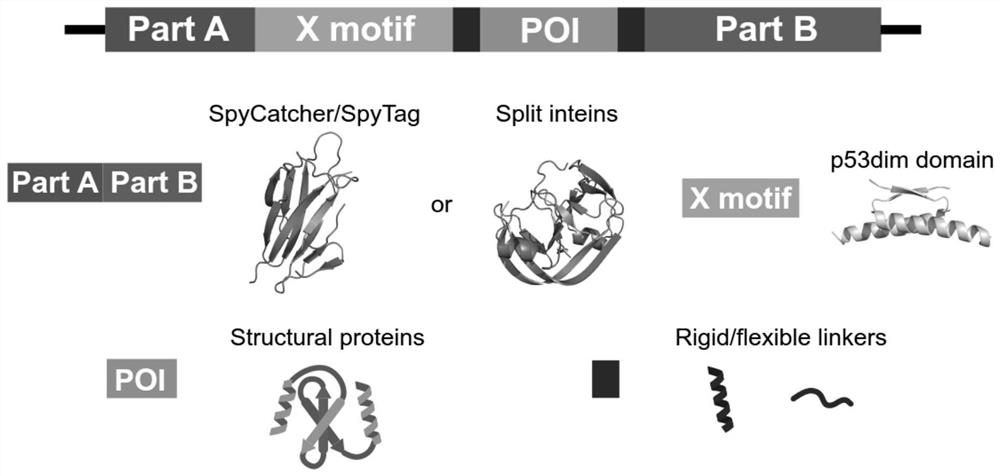Intracellular synthesis of BLA traceless soxo hydrocarbon by using separated intein as connection means and preparation method of intracellular synthesis of BLA traceless soxo hydrocarbon
A connection method and intein technology, applied in the field of protein coupling, to achieve the effect of reducing fusion components and improving retention
- Summary
- Abstract
- Description
- Claims
- Application Information
AI Technical Summary
Problems solved by technology
Method used
Image
Examples
Embodiment 1
[0038] Plasmid construction
[0039] In the traceless catenation strategy, the cyclization process is accomplished by an isolated intein. Since the intein reaction pair that achieves trans-cleavage is still composed of two parts, the peptide segment and the protein chaperone. In the design of BLA catenane precursors, the possible influence between each fusion domain needs to be considered, and the importance of rational design of connecting peptide chains is greatly increased. The length and properties of the connecting peptide chain have a great impact on the expression, folding and functional retention of the fusion protein, especially for proteins with larger and more complex structures. During intein-mediated catenane process, I NTrans-shearing and removal occurs, and only p53dim and BLA remain in the final catenane structure, but I N The protein chaperone of the reaction still needs proper folding, so in the design of the catenane precursor, the amino acid sequence (GG...
Embodiment 2
[0072] Protein expression and purification
[0073] The corresponding plasmids were transformed into BL21(DE3) competent cells. Single clones were picked on an overnight cultured agar plate, inoculated into 5 mL of 2xYT liquid medium containing 50 μg / mL kanamycin, and cultured overnight at 37°C with shaking. The bacteria cultured overnight was diluted 1:50 into 200 mL of optimized LB liquid medium containing the same concentration of antibiotics (1% tryptone, 0.5% yeast extract, 25mM disodium hydrogen phosphate, 25mM dipotassium hydrogen phosphate, 50 mM potassium chloride, 5 mM sodium sulfate, 2 mM magnesium sulfate, 0.5% glycerol, 0.05% glucose, 0.3 μg / mL vitamin B1, 16 μM calcium chloride, 8 μM manganese chloride, 8 μM zinc sulfate, 1.6 μM cobalt chloride, 1.6 μM nickel chloride, 1.6 μM sodium molybdate, 40 μM ferric chloride), shaking at 37°C to OD 600 =0.6-1.5. Isopropyl-β-D-thiogalactopyranoside (IPTG) was added to a final concentration of 1 mM and transferred to 20°C...
Embodiment 3
[0076] Protein characterization
[0077] The concentration of BLA series samples was determined by the extinction coefficient (calculated by ProtParam): wt-BLA: 0.904L / (g·cm); SpyX-BLA-RL: 0.825L / (g·cm); intX-BLA-RL: 0.818 L / (g·cm); intX-BLA-FL: 0.818 L / (g·cm).
[0078] Product distribution was characterized by SDS-PAGE: protein samples were mixed with 5x loading buffer (250 mM Tris, 50% glycerol, 10% SDS, 250 mM mercaptoethanol, 0.05% bromophenol blue) and loaded after heating at 98oC for 10 minutes . The relative quantification of protein was carried out in two ways: Unicorn 6.3 software was used to analyze the size exclusion chromatographic curve; Image J was used to analyze the SDS-PAGE band. see the results figure 2 (a)
[0079] The molecular weights of the samples were characterized using ultra-high performance liquid chromatography-electrospray ionization mass spectrometry. The charge-to-mass ratio data were analyzed by MassLynx V 4.1 software, and the molecular w...
PUM
| Property | Measurement | Unit |
|---|---|---|
| molecular weight | aaaaa | aaaaa |
Abstract
Description
Claims
Application Information
 Login to View More
Login to View More - R&D
- Intellectual Property
- Life Sciences
- Materials
- Tech Scout
- Unparalleled Data Quality
- Higher Quality Content
- 60% Fewer Hallucinations
Browse by: Latest US Patents, China's latest patents, Technical Efficacy Thesaurus, Application Domain, Technology Topic, Popular Technical Reports.
© 2025 PatSnap. All rights reserved.Legal|Privacy policy|Modern Slavery Act Transparency Statement|Sitemap|About US| Contact US: help@patsnap.com



